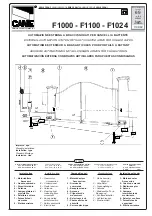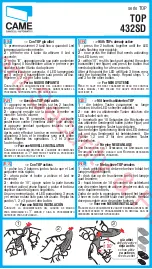
14
• These instructions are aimed at professionally qualified "
INSTALLERS OF
ELECTRICAL EQUIPMENT" and must respect the local standards and
regulations in force. All materials used must be approved and must suit the
environment in which the installation is situated.
• All maintenance operations must be carried out by professionally qualified
technicians.
• This appliance must be used exclusively for the purpose for which it has
been made. "
i.e. for the automation of sliding gates" with weights of up
to
400 kg and a maximum travel distance of 12 m.
• The geared motor can be positioned either to the
left or to the right of the
passageway. Any non authorised modifications are to be considered improper
and therefore dangerous.
Caution! The installation of both anti-derailment buffers
is absolutely obligatory.
It is the responsibility of the installer to make sure that the following public
safety conditions are satisfied:
1) Ensure that the gate operating installation is far enough away from the main
road to eliminate possible traffic disruptions and that the size of the gate, the
distance from the road and the work cycle speed can in no way interfere,
causing possible traffic hazards.
2) The motor must be installed on the inside of the property and not on the
public side of the gate. The gates must not open onto a public area.
3) The gate operator is designed for use on gates through which vehicles are
passing. Pedestrians should use a separate entrance.
4) The minimum controls which may be installed are OPEN-STOP-CLOSE,
these controls must be installed at a height between
1,5 and 1,8 m an in
a location not accessible to children. Controls installed externally must be
protected by a safety device inhibiting unauthorised use.
5) The gate must be in full view when it is operating therefore
controls must be situated in a position where the operator can
see the gate at all times.
6)
At least two warning signs (similar to the example on the
right) should be placed, where they can be easily seen by the
public, in the area of the system of automatic operation. One
inside the property and one on the public side of the installa-
tion. These signs must be indelible and not hidden by any objects
(such as tree branches, decorative fencing etc.). Make sure that the end-user
is aware that children and/or pets must not be allowed to play within the
area of a gate installation. If possible include this in the warning signs
7) A correct earth connection is fundamental in order to guarantee the electrical
safety of the machine
8) Before carrying out any cleaning or maintenance operations make sure the
power is disconnected at the mains, the motor power cables are discon-
nected and the batteries have been disconnected.
9) If you have any questions about the safety of the gate operating system,
do not install the operator. Contact your dealer for assistance.
• In order to respect the requirements of the standard
EN 12453 (dynamic
impact force limitation) make sure the current sensor is set to
SNS1.
Attention! If you use a rubber safety edge (at least 3 cm high) this is
obligatory in order to conform to the standard. If you can't respect
the limits, increase the size of the safety edge or change the type of
edge used.
• You are still obliged to check the impact force using the relative instru-
ment.
TECHNICAL DESCRIPTION
• Mains power supply
230 Vac.
•
Motor powered with a maximum voltage of 38 Vdc.
• A two-piece shell made of die cast aluminium enclosing the reduction unit
and a pair of steel gears, lubricated with permanently fluid grease.
• The reduction unit stator is made of die cast aluminium and contains worm
gear and a helicoidal crown wheel made of thermoplastic lubricated with
permanently fluid grease.
• The incorporated electronic programmer contains the power stage, the
logic control and the radio receiver decoding module. The power supply is
routed to the electronics card via a separate transformer which is housed
in the same container.
• Cover in shockproof plastic.
Accessories
106/CRENY - Rack (20 mm x 30 mm) in glass fibre with upper
fastening slits (
1 m).
106/CRENY1 - Rack (20 mm x 30 mm) in glass fibre with lower
fastening slits (
1 m).
106/SLOAC - Rack in galvanised steel (22 mm x 22 mm)
2 m to be welded.
106/SLOAC2 - Rack in galvanised steel (12 mm x 30 mm)
1 m with fastening slits.
950/xLbS
- Contact safety edge available in lengths of:
1,5 and 3,0 m maximum height 70 mm.
Attention! Only for EU customers - WEEE marking.
This symbol indicates that once the products life-span has expired
it must be disposed of separately from other rubbish. The user is
therefore obliged to either take the product to a suitable differen-
tial collection site for electronic and electrical goods or to send
it back to the manufacturer if the intention is to replace it with a
new equivalent version of the same product.
Suitable differential collection, environmental friendly treatment and disposal
contributes to avoiding negative effects on the ambient and consequently
health as well as favouring the recycling of materials.
Illicitly disposing of this product by the owner is punishable by law and will
be dealt with according to the laws and standards of the individual member
nation.
During the opening/closing manoeuvre check for correct operation and activate
the emergency stop button in case of danger. During normal operation wait
for the gate to open completely before crossing it.
During blackouts with a flat battery the gate can be released and manually
manoeuvred using the supplied release key (see manual release fig. 8). Periodi-
cally check the moving parts for wear and tear and grease if required, using
lubricants which maintain their friction levels unaltered throughout time and
are suitable for temperatures of
-20 to +70°C.
Eventual repair work must be carried out by specialised personnel using original
spare parts. The appliance is not suitable for continuous operation and may
only be operated using a duty cycle of
90%.
Before starting the installation make sure that the structure which is to be
automated is in good working order and respects the local standards and
regulations in force.
To this end ensure that:
- The surface of the sliding gate "
A" is smooth and has no protrusions up to
a distance of
2.5 m from ground level.
Protrusions on the gate surface which are not greater than
3 mm and have
rounded edges are acceptable.
If the surface of the gate is not smooth, the entire height up to
2.5 m from
the ground must be protected by two of the following devices:
a) photoelectric cells
b) contact safety buffer
- the distance "
b" between the fixed parts and sliding parts of the installation
must not exceed
15 mm.
- the runner guide "
C", preferably round, should be securely fixed to the
ground, completely exposed and free of any imperfections which could
inhibit the correct movement of the gate.
- when the gate is closed a space of
50 mm "D" must remain for the entire
height of the front part of the gate and a mechanical travel limit "
E" must
be positioned on the upper part of the gate.
- The free space "
D" can be covered with a rubber anti-crush buffer "F" or
better still a pneumatic or photoelectric contact safety buffer.
- if the gate slides past a fixed structure "
G" which has railings or bars leaving
open spaces, it must be protected in one of the following ways:
1. distance "
H" greater than 500 mm: no protection required;
2. distance "
H" between 500 and 300 mm: wire mesh fencing "I" or punched
metal plating "
L" with an opening which does not allow the passage of a
25 mm diameter sphere "M" must be fitted;
IMPORTANT REMARKS
IMPORTANT REMARKS
IMPORTANT REMARKS
IMPORTANT SAFETY INSTRUCTIONS
Q
READ THE FOLLOWING REMARKS CAREFULLY bEFORE PROCEEDING WITH THE INSTALLATION. PAY PARTICU-
LAR ATTENTION TO ALL THE PARAGRAPHS MARKED WITH THE SYMbOL
. NOT READING THESE IMPORTANT
INSTRUCTIONS COULD COMPROMISE THE CORRECT WORKING ORDER OF THE SYSTEM AND CREATE DANGER
SITUATIONS FOR THE USERS OF THE SYSTEM.
USER INSTRUCTIONS
AUTOMATIC OPENING
KEEP CLEAR
CHILDREN OR PETS MUST NOT
bE ALLOWED TO PLAY ON OR
NEAR THE INSTALLATION
WARNING
PRELIMINARY CHECKS (fig. 1, page 2)
Summary of Contents for 424EBSS
Page 50: ...50 NOTES...















































